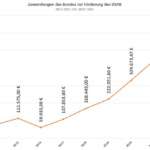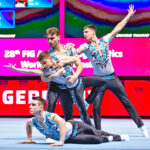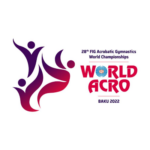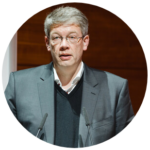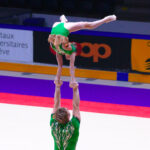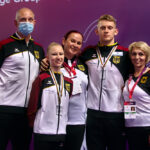Rosy Taeymans: One day we will be in the Olympics!
At the 2nd European Games in Minsk I spotted a very special and famous guest amongst the spectators: Worldwide chief of Acrobatic Gymnastics Rosy Taeymans from Belgium, President of the Acrobatics Gymnastics Technical Committee (Acro TC) in the Fédération Internationale de Gymnastique (FIG). There was even the opportunity for an interview.
Schipfel: What are your personal impressions about these Games, for example here the Gymnastics competitions, but also the Games in general, the opening ceremony, the city of Minsk and things like this?
Taeymans: First of all, I’m very happy that after the 1st European Games (EG) in Baku the European Olympic Committee (EOC) found such a good organizer as Minsk and Belorussia. For Europe it’s very important to have its own Games and the city of Minsk does a great job. I was really impressed about the Opening Ceremony. It was high class, with symphonic orchestra, live choir, opera singers… It really was full of emotions and I liked it a lot. It was really great to be part of it.
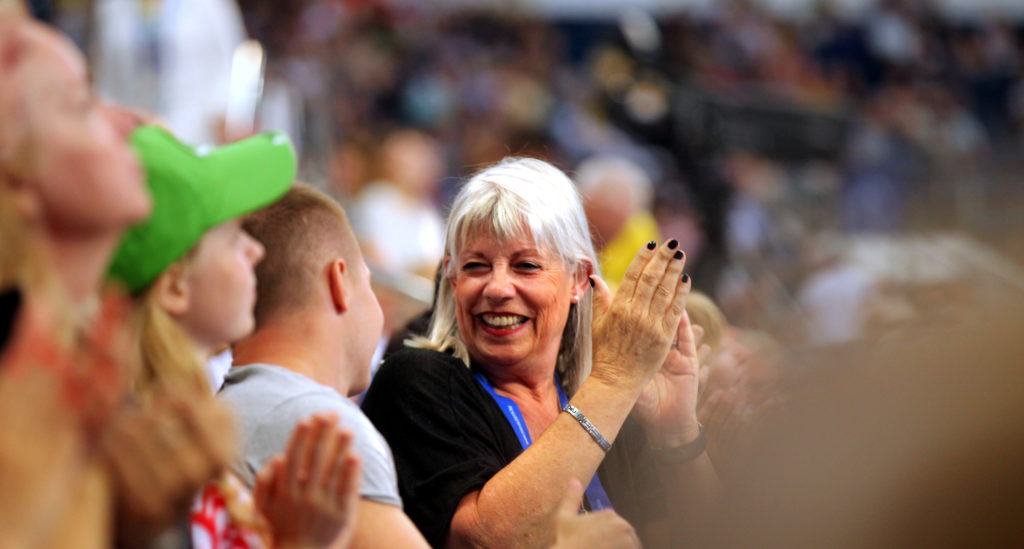
What does it mean for Acrobatic Gymnastics to be part of these European Games?
It’s so important for Acrobatics because these are Continental Games and they are under the supervision of the International Olympic Committee (IOC). That means that here we are part of the Olympic family of Europe. That’s a big step forwards for Acrobatics.
Multisport competitions like these are the only places where we can show off and show Europe and the World what Acrobatic Gymnastics is. Because we are not an Olympic discipline, we are not on television very often and we are not known by many people. But when they see it, they love it. That’s why it’s so important to be here. And it’s great to have already two disciplines here, Mixed Pairs and Women’s Groups, after the big step into the Youth Olympic Games (YOG), where we only had one discipline, the Mixed Pairs. All of this in addition to participating in the World Games with all our five disciplines.
Will Acrobatics have to focus? Maybe on Mixed Pairs??
At the moment we have to focus on the Mixed Pairs, because of the equality for both genders, which is very important in the IOC. With Mixed Pairs we don’t disturb the balance between men and women in FIG participation. Of course, if we had 25 Men’s Groups, I would love that and we would conquer the World with this spectacular competition, but the problem about the balance between the number of men and women stays. That’s why they decided to send Mixed Pairs as the one discipline for YOG and not Women’s Groups as stated before.
Acrobatics has made three great steps lately (EG in Baku, YOG in Buenos Aires, EG in Minsk). What will be, or have to be, the next steps, and when will they come?
It’s going to be really hard because the quota is limited in the Olympics. In my opinion there are only a few options to get in the Olympics:
- The structure inside the FIG changes. We look at Gymnastics as one sport and one family altogether like they do in Athletics: In Athletics it doesn’t matter which discipline you are. You are an Olympic discipline and you go to the Olympics. In this case the quota must go up.
- Then of course we have to do our own job. We have to organize ourselves really well. We have to keep focussing on good judging, so that the public and the media can understand our sport. We have to simplify and to make very clear rules. It must be very obvious who’s winning, who’s losing and why.
- And third one is of course to promote ourselves and to grow. Getting Acrobatics in the Olympics is only by growing, which means much more countries participating at senior level, and spreading the passion about Acrobatics around the World. Like we do at the moment with the help of FIG: for example, the Age Groups development plan, all the camps that are organized around the world, more and more coaches get involved in Acrobatics and spread it around the world. Acrobatics is really growing fast in the Pan-American Gymnastic Union (PAGU). Hopefully the same will happen in Asia and Africa but it will take time.
I’m very thankful for the beautiful image and the exciting impressions, which our athletes and their coaches are giving on the floor here in Minsk. The members of the IOC and of all the National Olympic Committees and their Presidents are here and that’s a great opportunity. These people talk about Acrobatics and ask questions such as “Why is this not an Olympic discipline?”. That’s what we need.
Have you got a concrete next step in mind?
Not at the moment. I don’t have any clue. We have to work really hard. We have to put ourselves in the pictures. And for me the most important thing is that young people who are now involved in Acrobatics have the same passion and the same emotional belief that we are a really beautiful discipline in Gymnastics. We have to believe in ourselves and that we are worth to be in the Olympics. But we have to do it ourselves and nobody is going to do it for us. We have to continue what we have been doing now for several years: Fighting and trying and proving that we are worth it. I’m convinced that one day we will be there! I believe it! If we, the Acro community, don’t believe it anymore it’s over and out.
Doping could ruin all these efforts. There are rumours about a case at YOG, can you confirm that?
At this point: no! It’s only rumours. I don’t have any official paper, message, telephone call. Nothing! I know the rumours of course. But if there’s one thing we as a TC have to stay out of it’s everything about doping. It’s medical, it’s personal. If some coach spreads rumours, it doesn’t mean it is true. As President of the Acro TC I can only say that as long I don’t get an official notification from FIG, there is no case.
What about the Russian trio here at the European Games?
The only thing I heard, but of course not officially because I’m FIG and not UEG, is that it has to do with medical reasons, so that’s all.
But let me turn it into a message to all the Acro community: When we get in a mess with doping, with cheating, with doing things not right, we will never grow. The only thing that can help us to grow is respect from the parents, from the public, from the international federations, from the media, that we do everything we can to keep our sport clean and fair. And of course, we are not a discipline that can be “helped” a lot with doping. Most cases that happen are “accidental” cases. Not enough attention from the coach or gymnast or parents on what medication is allowed and what is not allowed. We don’t have a problem with doping, but we have to protect ourselves as a sport. We have to protect our young ones. These are young people, these are beautiful young sportsmen, who give their lives for our discipline. They train really hard, but there is a life after that. So, the protection of the athletes in any way is really important and we have to focus on that also. It has always been really important for me.
Here at the European Games we saw finals without qualifications in the balance and dynamic competitions. What do you think about that?
(laughs) That was really interesting for me. It’s something that will never happen in a competition of FIG because it’s just not possible. But if that was the only way that worked here, why not? When I saw that yesterday Rhythmic Gymnasts can win an overall medal and today, they can win a medal in every apparatus, why can’t we get medals in each exercise? Why not?? This is the only opportunity to be on the podium more than one time and get more attention from the media to become a “star”. I’m fine with that.

Also in FIG the competition format of Acrobatic Gymnastics World Championships will be changed. I can officially announce that because it’s been published in the minutes of the decisions of the FIG Executive Committee (EC) already. But I’m not going to declare what programme exactly it’s going to be yet. That’s up to the Acro community to find out in an official way. And everybody will be informed way up in advance. The proposals of the Acro TC accepted by the EC are a result of the round tables discussions that we held in Antwerp. Some of them were accepted, some of them were not.
What main topics is FIG Acro TC working on at the moment?
Our daily work at the moment is to get the first drafts of the Code of Points, the Age Group Rules and the Tables of Difficulty ready to be sent out in September to all federations. We have already taken all the decisions, now we are updating the documents and making them clean. In September coaches and federations can look at all the changes and give their feedback which we will evaluate of course. Then in February the EC will have to approve the final version and then it will be published already so that everybody has got minimum eight months before the new cycle and minimum six months before the Intercontinental Judges’ Courses.
Will there be major changes?
No! Of
course, there will be changes, but only to make it easier and to solve problems.
Because every time the same problems occur: about difficulty, about tariff
sheets, about transitional pyramids and individual elements even though they
are not a special requirement anymore. Questions about individual elements keep
coming up. So, we took decisions on that.
The Tables of Difficulty are always defining what’s happening on the floor. Therefore,
we evaluated the content of the exercises of the last major competitions: What have
we seen on the floor too many times? Which elements do we not like to see in
the future? What do we like and want to see more often? We adjusted the Tables of
Difficulty according to that. And they will also be not so extended any more.
We reduced the number of elements again. We have done it before in pairs and
now we did it in groups.
What about the last major changes: difficulty mark, doubling execution mark, positive artistic marks, limitation of the number of elements. Was this a success?
Not only in my opinion, but in the opinion of all the Acro TC members: Yes! We are really convinced that this is the right direction. We are not there yet of course, but it’s certainly the right direction and that’s where we need to go. Execution is really important. The public and the media will never understand that if you fall you still can win the gold medal!
There used to be differences between the Acro TCs of FIG and UEG about judging, for example, and about the influence of the superior jury. Has this improved?
It’s a different way of working. I really think that continents have to do their own jobs in the continental Acro TCs to make sure that everything goes round in their continent and that they’re growing in their continent.
But about judging of course it should be in the same line and about applying the Code of Points in the same way around the world. There should not be a different interpretation! However, I think it improved a lot. We still have some work to do, but we have a good contact with Carine Charlier, President of the UEG Acro TC, and the UEG Acro TC members and I still have contact with Tonya Case, who is now President of PAGU Acro TC.
We also still have some work to do in Asia and Africa. In the past we have spent a lot of time in explaining the rules again and again, but in this cycle and in the future, we have to spend much more time on practical judges’ education. The focus has to move. You know when you are crawling you have to try to get up. And then, when you stand you have to learn to walk. At the moment we are walking, we are even starting to run. Now we have to make our style more perfect.
There is nothing like tiredness in your words. Can you confirm the Acro community that you will keep fighting for Acrobatics another cycle? What are your personal plans?
First of all, it doesn’t depend only on myself. I have to ask my federation whether they will support me another four years. But what is really important for me is whether the Acro community still supports me and my way of doing things. Because I know I’m very explicit in the way I do and say things and express my opinion always in a strong and passionate way.
But: Do I have the ambition? Yes! Do I have still the passion? Yes!
But I also think it’s really important that young people prepare themselves to take over. Because by now I’m almost a dinosaur in Acrobatics. When I look around, I don’t see many people anymore from the time I started. I will never stop young people with a lot of ambition, so, if there is a candidate with the necessary qualifications, that says “Rosy, I’m ready! I feel that I can do it!” then I will step aside.
I have been an international judge since 1986 so I’ve been around for a long time. At the end of this cycle next year I will have been twenty years in the committee. Twelve years as a member and then eight years as a president. The maximum you can do as a president is twelve years. It’s a long time but yes, I will continue to work and fight for Acrobatics if that’s what’s been expected and wanted.
Thank you for this interview! Good luck and all the best!
Thank you!
Category: Europaspiele 2019 in Minsk, Personalien und Verbandsangelegenheiten


